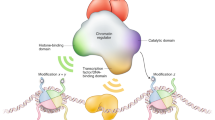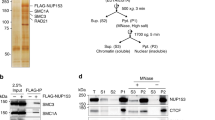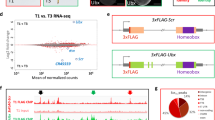Abstract
LIM domains1 are required for both inhibitory effects on LIM homeodomain transcription factors and synergistic transcriptional activation events1,2,3,4. The inhibitory actions of the LIM domain can often be overcome by the LIM co-regulator known as CLIM2, LDB1 and NLI (referred to hereafter as CLIM2; refs 2, 3, 4). The association of the CLIM cofactors with LIM domains does not, however, improve the DNA-binding ability of LIM homeodomain proteins4,5, suggesting the action of a LIM-associated inhibitor factor. Here we present evidence that LIM domains are capable of binding a novel RING-H2 zinc-finger protein, Rlim (for RING finger LIM domain-binding protein), which acts as a negative co-regulator via the recruitment of the Sin3A/histone deacetylase corepressor complex. A corepressor function of RLIM is also suggested by in vivo studies of chick wing development. Overexpression of the gene Rnf12, encoding Rlim, results in phenotypes similar to those observed after inhibition of the LIM homeodomain factor LHX2, which is required for the formation of distal structures along the proximodistal axis, or by overexpression of dominant-negative CLIM1. We conclude that Rlim is a novel corepressor that recruits histone deacetylase-containing complexes to the LIM domain.
This is a preview of subscription content, access via your institution
Access options
Subscribe to this journal
Receive 12 print issues and online access
$209.00 per year
only $17.42 per issue
Buy this article
- Purchase on Springer Link
- Instant access to full article PDF
Prices may be subject to local taxes which are calculated during checkout





Similar content being viewed by others
References
Dawid, I.B., Breen, J.J. & Toyama, R. LIM domains: multiple roles as adaptors and functional modifiers in protein interactions. Trends Genet. 14 , 156–162 (1998).
Taira, M., Otani, H., Saint-Jeannet, J.-P. & Dawid, I.B. Role of the LIM class homeodomain protein Xlim-1 in neural and muscle induction by the Spemann organizer in Xenopus. Nature 372, 677–679 (1994).
Agulnick, A.D. et al. Interactions of the LIM-domain-binding factor Ldb1 with LIM homeodomain proteins. Nature 384, 270– 272 (1996).
Bach, I., Carrière, C., Ostendorff, H.P., Andersen, B. & Rosenfeld, M.G. A family of LIM domain interacting cofactors confer transcriptional synergism between LIM and Otx homeoproteins. Genes Dev. 11, 1370–1380 (1997).
Jurata, L.W. & Gill, G.N. Functional analysis of the nuclear LIM domain interactor NLI. Mol. Cell. Biol. 17, 5688–5698 (1997).
Freemont, P.S. The RING finger. A novel protein sequence motif related to the zinc finger. Ann. N. Y. Acad. Sci. 684, 174– 192 (1993).
Tranque, P., Crossin, K.L., Cirelli, C., Edelman, G.M. & Mauro, V.P. Identification and characterization of a RING zinc finger gene (C-RZF) expressed in chicken embryo cells. Proc. Natl Acad. Sci. USA 93, 3105– 3109 (1996).
Jurata, L.W., Kenny, D.A. & Gill, G.N. Nuclear LIM interactor, a rhombotin and LIM homeodomain interacting protein, is expressed early in neuronal development. Proc. Natl Acad. Sci. USA 93, 11693– 11698 (1996).
Toyama, R., Kobayashi, M., Tomita, T. & Dawid, I.B. Expression of LIM-domain binding protein (ldb) genes during zebrafish embryogenesis. Mech. Dev. 71, 197–200 (1998).
Bach, I. et al. P-Lim, a LIM homeodomain factor, is expressed during pituitary organ and cell commitment and synergizes with Pit-1. Proc. Natl Acad. Sci. USA 92, 2720–2724 (1995).
Schoorlemmer J. et al. Ring 1A is a transcriptional repressor that interacts with the polycomb-M33 protein and is expressed at rhombomere boundaries in the mouse hindbrain. EMBO J. 19, 5930– 5942 (1997).
Moosmann, P., Georgiev, O., Le Douarin, B., Bourquin, J.P. & Schaffner W. Transcriptional repression by RING finger protein TIF β that interacts with the KRAB repressor domain of KOX1. Nucleic Acids Res. 24, 4859–4867 (1996).
Torchia, J., Glass, C.K. & Rosenfeld, M.G. Co-activators and co-repressors in the integration of transcriptional responses. Curr. Opin. Cell Biol. 10, 373–383 (1998).
Heinzel, T. et al. A complex containing N-CoR, mSin3 and histone deacetylase mediates transcriptional repression. Nature 387, 43–48 (1997).
Laherty, C.D. et al. SAP30, a component of the mSin3 corepressor complex involved in N-CoR-mediated repression by specific transcription factors. Mol. Cell 2, 33–42 ( 1998).
Nagy, L. et al. Nuclear receptor repression mediated by a complex containing SMRT, mSin3A, and histone deacetylase. Cell 89, 373–380 (1997).
Vogel, A., Rodriguez, C., Warnken, W. & Izpisúa Belmonte, J.C. Dorsal cell fate specified by chick Lmx1 during vertebrate limb development. Nature 378, 716– 720 (1995).
Riddle, R. et al. Induction of the LIM homeobox gene Lmx-1 by Wnt7a establishes dorsoventral pattern in the vertebrate limb. Cell 83 , 631–640 (1995).
Rodriguez-Esteban, C. et al. Lhx2, a vertebrate homologue of apterous, regulates vertebrate limb outgrowth. Development 125, 3925–3934 (1998).
Mahmood, R. et al. A role for FGF8 in the initiation and maintenance of vertebrate limb bud outgrowth. Curr. Biol. 5, 797– 806 (1995).
Crossley, P.H., Minowada, G., MacArthur, C.A. & Martin, G.R. Roles for FGF-8 in the induction, initiation and maintenance of chick limb development. Cell 84, 127– 136 (1996).
Vogel, A., Rodriguez, C. & Izpisúa Belmonte, J.C. Involvement of FGF-8 in initiation, outgrowth and patterning of the vertebrate limb. Development 122, 1737–1750 (1996).
Laufer, E., Nelson, C.E., Johnson, R.L., Morgan, B.A. & Tabin, C. Sonic hedgehog and Fgf-4 act through a signaling cascade and feedback loop to integrate growth and patterning of the developing limb bud. Cell 79, 993 –1003 (1994).
Chiang, C. et al. Cyclopia and defective axial patterning in mice lacking Sonic hedgehog gene function. Nature 383, 407– 413 (1996).
Breen, J.J., Agulnick, A.D., Westphal, H. & Dawid, I. Interactions between LIM domains and the LIM domain-binding protein Ldb1. J. Biol. Chem. 273, 4712– 4717 (1998).
Morcillo, P., Rosen, C., Baylies, M.K. & Dorsett, D. Chip, a widely expressed chromosomal protein required for segmentation and activity of a remote wing margin enhancer in Drosophila. Genes Dev. 11, 2729–2740 (1997).
Niswander, L., Tickle, C., Vogel, A., Booth, I. & Martin, G.R. FGF-4 replaces the apical ectodermal ridge and directs outgrowth and patterning of the limb. Cell 75, 579–587 (1993).
Morgan, B.A., Izpisúa Belmonte, J.C., Duboule, D. & Tabin, C.J. Targeted misexpression of Hox-4.6 in the avian limb bud causes apparent homeotic transformations. Nature 358, 236– 239 (1992).
Acknowledgements
We thank C. Kintner for initial X. laevis mRNA injections; O. Bernard for the Kiz-1 expression plasmid; C. Nelson for cell culture; P. Meyers for assistance in figure preparation; M. Fisher for assistance in manuscript preparation; E. De Robertis, E. Osmundson, M. Ruchhoef, S. O'Connell, M. Wegner and R. Stan for providing reagents and advice; and A. Ryan and H. Ostendorff for comments on the manuscript. C.C. was a fellow of the LALOR Foundation. This work is supported by NIH grants to B.A. (AR044882 and AR02080), J.C.I.B. and M.G.R.; by the Irving Weinstein Foundation to B.A.; and by a G. Harold and L.Y. Mathers Charitable Foundation grant to J.C.I.B.
Author information
Authors and Affiliations
Corresponding authors
Rights and permissions
About this article
Cite this article
Bach, I., Rodriguez-Esteban, C., Carrière, C. et al. RLIM inhibits functional activity of LIM homeodomain transcription factors via recruitment of the histone deacetylase complex. Nat Genet 22, 394–399 (1999). https://doi.org/10.1038/11970
Received:
Accepted:
Issue Date:
DOI: https://doi.org/10.1038/11970
This article is cited by
-
RNF12 is regulated by AKT phosphorylation and promotes TGF-β driven breast cancer metastasis
Cell Death & Disease (2022)
-
A novel approach to differentiate rat embryonic stem cells in vitro reveals a role for RNF12 in activation of X chromosome inactivation
Scientific Reports (2019)
-
Pathogenic variants in E3 ubiquitin ligase RLIM/RNF12 lead to a syndromic X-linked intellectual disability and behavior disorder
Molecular Psychiatry (2019)
-
Characterization and tissue distribution of Lhx9 and Lhx9 α in Chinese giant salamander Andrias davidianus
Journal of Genetics (2016)
-
X-exome sequencing of 405 unresolved families identifies seven novel intellectual disability genes
Molecular Psychiatry (2016)



